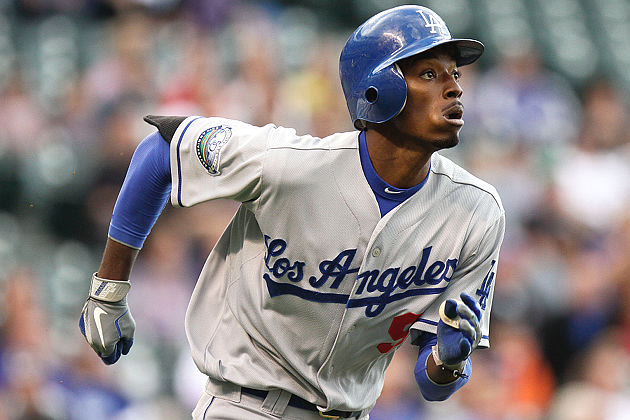I was recently involved in an online discussion of the Prince Fielder/Ian Kinsler trade and the signing of Jhonny Peralta by the St. Louis Cardinals. Someone stated that Peralta was no more than a utility infielder who could sometimes hit. I pointed out that, over the last 3 seasons, Peralta was actually a top 5 SS. Someone else stated that Prince, were he to play SS, would also be a top 5 SS. I thought that was ridiculous, but decided I'd try to look at it as objectively as possible.
Over the last 3 seasons, Fielder has 111 batting runs, -18 base running runs, 61 replacement runs and -10 fielding and -37 positional runs for 107 total runs.
*
source
If we assume that his batting, base running and overall playing time would stay the same, which is probably an optimistic assumption given the likely additional strain of playing SS instead of 1B, then we only need to adjust his positional and defensive runs.
The positional adjustment is the easiest to adjust. The adjustment for 1B is -12.5 runs per 1350 innings, the adjustment for SS is +7.5 runs per 1350 innings. Fielder's -37 positional runs represent (-37/-12.5) 3.0 defensive seasons. Three defensive seasons at SS is worth (3 * 7.5) 23 runs.
At this point Fielder at SS is worth 111 batting runs+-18 base running runs+23 positional runs+61 replacement runs. That's 167 runs all told. That'd make him, by far, the best SS in the league. Troy Tulowitzki has 114 runs.
But we still haven't factored in Fielder's defense compared to the average SS. I'm not really sure that we can.
Fielder has been about 6 runs worse than the average 1B each season of his career. But the average SS is a much better defensive player than the average 1B.
I think it's safe to assume that Fielder would be the worst defensive SS in baseball.
Since 2002, the UZR era, the worst season by a SS (minimum 650 innings, about half a season) is Dee Gordon's 2012 season in which UZR says he was worth -27 runs per 1350 innings.
*http://www.fangraphs.com/leaders.aspx?pos=ss&stats=fld&lg=all&qual=650&type=1&season=2013&month=0&season1=2011&ind=1&team=0&rost=0&age=0&filter=&players=0&sort=25,a
That's a somewhat amusing comparison. Dee Gordon is listed at 5'11" 160 lbs. Prince is listed at 5'11" 275 lbs. Those are listed weights and I think it's entirely possible that Prince weighs twice as much as Gordon.
http://forums.prosportsdaily.com/showthread.php?813284-Easiest-defensive-position-to-play-in-baseball/page6
http://ca.sports.yahoo.com/blogs/mlb-big-league-stew/juice-marlins-beat-giants-bury-may-rays-win-121523585.html
I'm going to go out on a limb as say that Prince would be a worse defensive SS than Gordon. I'd go so far as to say that he would be considerably worse. But how much is considerably?
UZR can be broken down into different components.
Range runs - attempts to measure a player's range; how many balls he does/doesn't get to compared to average.
Error runs - attempts to measure how many runs a player saves/costs his team by avoiding/making errors
Double play runs - attempts to measure how many runs a player saves/costs his team by turning/not turning double plays.
I'm going to assume that Fielder would be the worst at all 3 of the above. So, what would that look like for Fielder's overall defensive worth at SS?
It's worth noting here that most of Gordon's poor UZR was due to making errors, his range and double plays were bad, but not historically bad. His errors were.
The worst SS in terms of double play runs (per 1350 innings) was, go figure, 2012 Dee Gordon at -5 runs per 1350 innings. If we say that Fielder was equally as bad as Gordon, I've little doubt he'd be much worse than Gordon, that'd be (3*-5)-15 runs over the 3 seasons.
The worst SS in terms of range runs was, not surprisingly, 2012 Derek Jeter at -17.5 runs per 1350 innings. Anyone think that Fielder has Jeter's range? I don't. But if we give Fielder 3 seasons as poor as Jeters' 2012 that's (3*-17.5) -53 runs for 3 seasons.
The worst SS in terms of error runs, bet you guessed that it, was 2012 Dee Gordon at -13 runs per 1350 innings. Again, I think that Dee's footwork and hands around 2B would be much better than Fielder's, but if we say that Fielder was as good as Gordon then he'd be worth (3*-13) -39 runs per the 3 seasons.
If we add all of that up (and remembering that this is-I believe-an optimistic look at Fielder's possible performance at SS, we get Fielder being (-15-53-39) -107 runs worse than the average SS. Quite a bit worse than Gordon's -27 runs
Let's add that to his other performance from above:
111 batting runs, -18 base running runs, -107 fielding runs, 23 positional runs, 61 replacement runs = 71 total runs.
71 total runs between 2011 and 2013 would have put Fielder 12th among major league SS, between Hanley Ramirez (84 runs) and Marco Scutaro (70 runs), and worth about 2.5 WAR per season.
*http://www.fangraphs.com/leaders.aspx?pos=ss&stats=bat&lg=all&qual=y&type=6&season=2013&month=0&season1=2011&ind=0&team=0&rost=0&age=0&filter=&players=0
To emphasize again, I think these are the
most ridiculously optimistic assumptions that I can present with a straight face. I think it much more likely that Fielder would be a -50 (per 1350 innings) or worse SS were he to play there everyday. Not to mention the additional strain on his body that would decrease his hitting, baserunning, and ability to play everyday.





